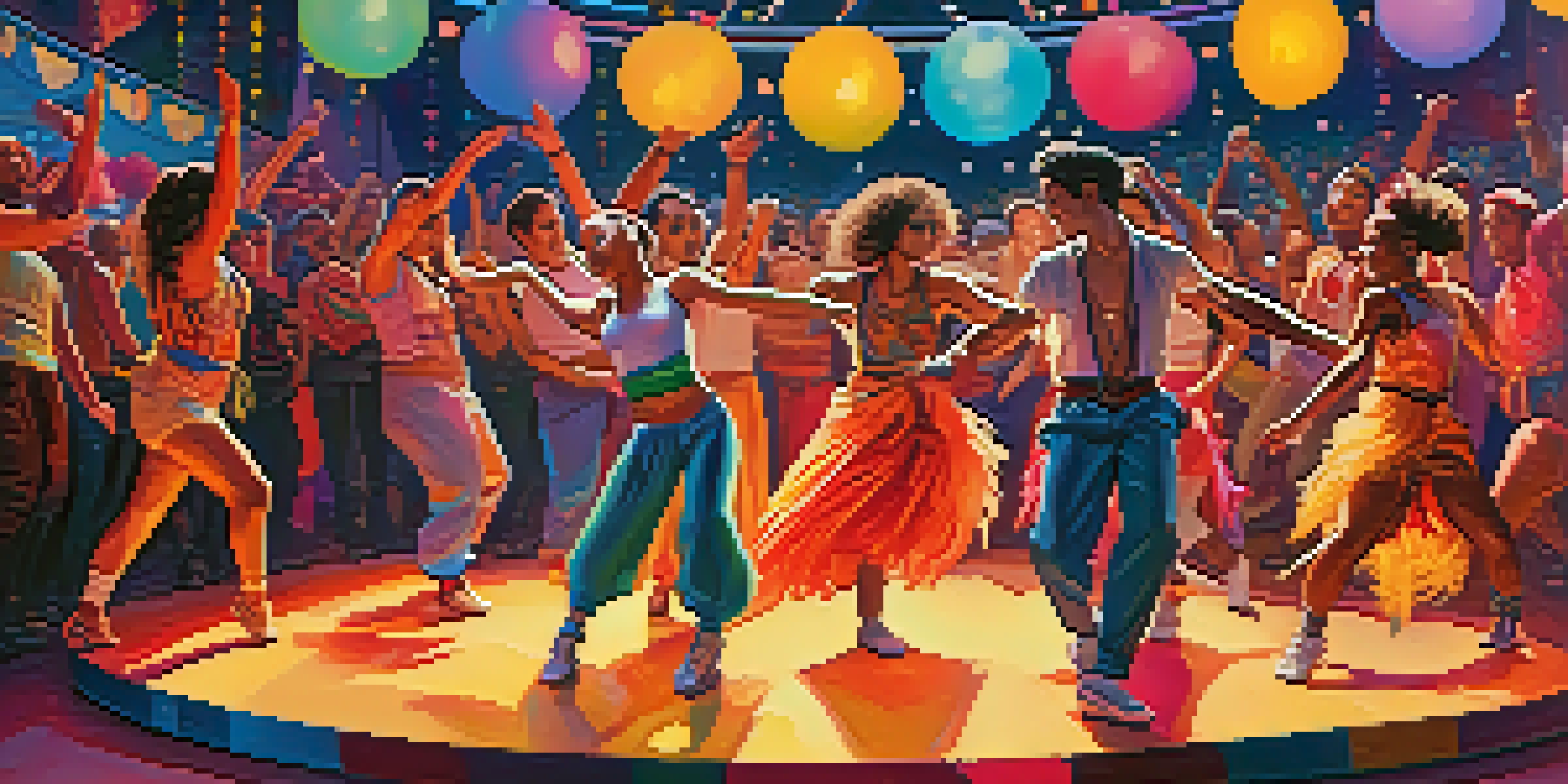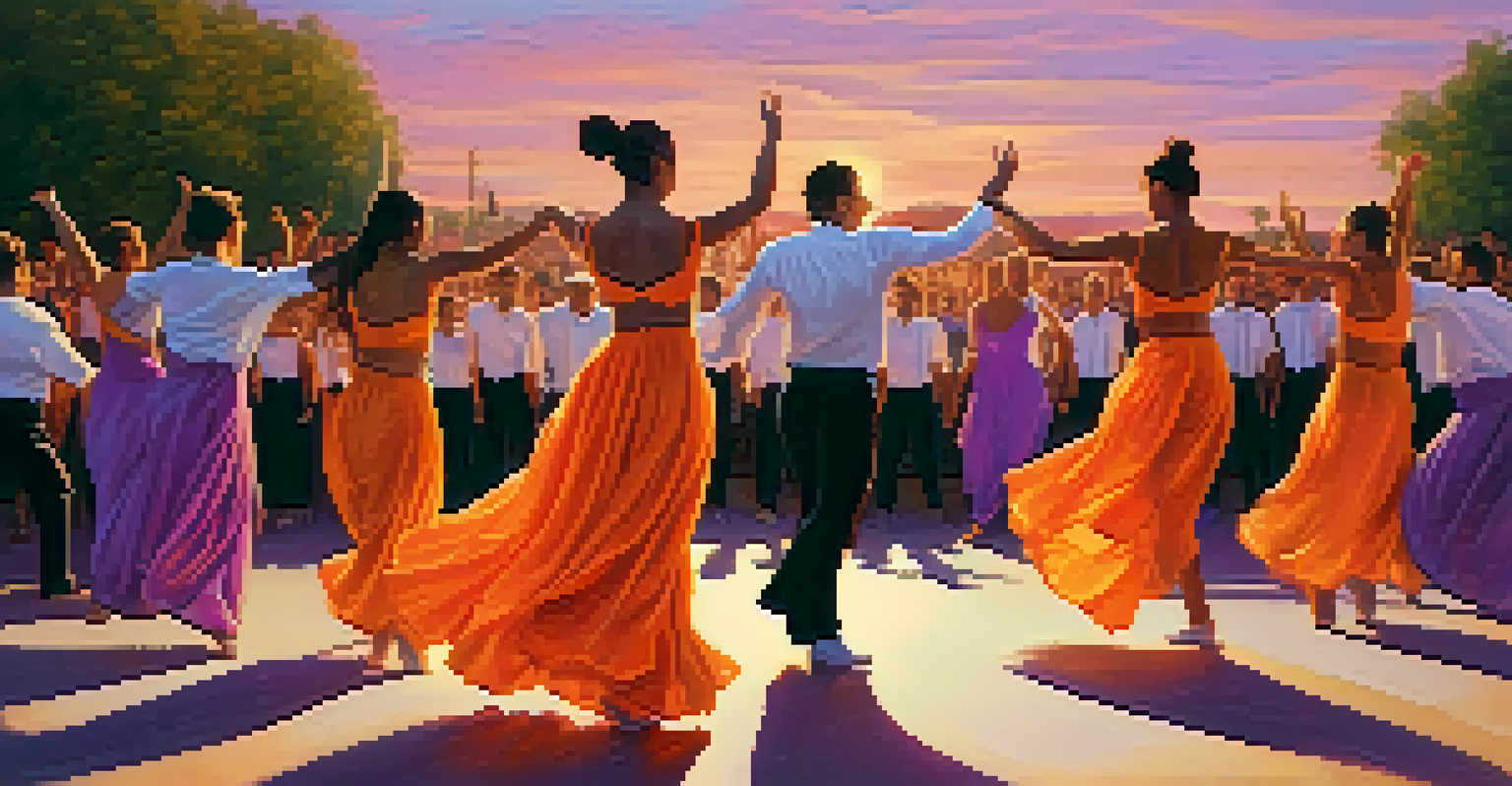Dance Festivals: Celebrating Gender Diversity in Movement

The Importance of Gender Diversity in Dance Festivals
Dance festivals serve as a vibrant platform for showcasing the multifaceted nature of gender diversity. They allow artists of all gender identities to express themselves freely, breaking away from traditional norms. This inclusivity is crucial in fostering an environment where everyone feels valued and represented.
Dance is the hidden language of the soul.
Incorporating various gender perspectives enriches the artistic experience for both performers and audiences alike. It challenges the conventional notions of masculinity and femininity, allowing dancers to explore their identities through movement. This creates a space where everyone can connect with the art form on a deeper level.
Moreover, the celebration of gender diversity at these festivals often leads to educational opportunities. Workshops and discussions can help attendees understand the nuances of gender expression, paving the way for greater acceptance in society. Ultimately, this fosters a more inclusive culture both within and beyond the dance community.
How Dance Festivals Challenge Traditional Gender Roles
Many dance festivals actively challenge traditional gender roles by promoting performances that defy stereotypes. For instance, male dancers may take on roles typically associated with femininity, and vice versa, showcasing the fluidity of gender. This not only broadens the audience's understanding but also encourages self-exploration among performers.

Such challenges to conventional roles can spark meaningful conversations about gender identity and expression. Audiences witness firsthand the power of movement as a form of communication that transcends spoken language. In this way, dance becomes a unifying force that encourages acceptance and understanding.
Dance Festivals Celebrate Diversity
Dance festivals provide a vibrant platform for showcasing and promoting gender diversity, allowing artists to express themselves freely.
Additionally, these festivals often feature collaborations between dancers of different gender identities, creating innovative and thought-provoking performances. This artistic synergy highlights the beauty of diversity, showing that when artists unite, they can create something truly extraordinary. It’s a reminder that dance, at its core, is about connection.
Spotlight on Notable Dance Festivals Championing Diversity
Several dance festivals around the world have gained recognition for their commitment to gender diversity. Events like the San Francisco Dance Festival and the New York Queer Dance Festival prioritize inclusivity, showcasing a wide range of performances that celebrate various identities. These festivals not only entertain but also educate, making them pivotal in the dance community.
We are not just bodies; we are souls that dance.
At these festivals, audiences can enjoy a diverse array of styles, from contemporary to traditional, all while witnessing unique interpretations of gender. This variety ensures that there’s something for everyone, fostering a welcoming atmosphere. The performances often reflect personal stories, creating relatable experiences that resonate with viewers.
Moreover, the presence of diverse voices on stage inspires the next generation of dancers. Young artists see that there is a place for them in the dance world, regardless of their gender identity. This representation can be incredibly empowering, encouraging them to pursue their passions without fear of judgment.
The Role of Community in Dance Festivals
Community plays a vital role in the success of dance festivals, especially when it comes to celebrating gender diversity. Festivals often bring together local artists, activists, and audiences, creating a supportive network that uplifts diverse voices. This sense of belonging fosters creativity and collaboration, essential ingredients for impactful performances.
Moreover, community involvement allows for a richer festival experience. Attendees can participate in workshops, discussions, and social events that promote understanding and acceptance. By engaging with one another, individuals can share their stories and perspectives, further enriching the celebration of diversity.
Challenging Gender Norms Through Dance
By featuring performances that defy traditional gender roles, dance festivals encourage self-exploration and foster meaningful conversations about identity.
Ultimately, the sense of community established at these festivals extends beyond the event itself. Participants often carry the lessons learned and connections made back into their everyday lives. This ripple effect can lead to lasting change in how society views and accepts gender diversity.
Dance as a Medium for Gender Expression
Dance serves as a powerful medium for gender expression, allowing individuals to convey their identities and experiences through movement. This form of expression can be particularly liberating for those who may struggle to articulate their feelings verbally. The fluidity of dance transcends language barriers, enabling a more profound connection with audiences.
Many choreographers intentionally incorporate themes of gender identity in their works, using dance to tell stories that resonate with a broad audience. For instance, a piece might explore the journey of self-acceptance, showcasing the challenges and triumphs faced by individuals of diverse genders. Such narratives can be both poignant and educational, encouraging empathy among viewers.
As dance continues to evolve, so too does its role in advocating for gender diversity. Artists are increasingly using their platforms to raise awareness about issues affecting the LGBTQ+ community, making dance not just an art form but also a vehicle for social change. This intersection of art and activism is what makes dance festivals so impactful.
The Future of Dance Festivals and Gender Diversity
The future of dance festivals looks promising, especially regarding the ongoing celebration of gender diversity. As society continues to evolve, so does the understanding of gender, leading to more inclusive practices within the dance community. This shift ensures that festivals will continue to serve as platforms for underrepresented voices.
Emerging trends indicate a growing interest in intersectionality, where gender diversity intersects with other identities such as race and disability. This holistic approach enriches the festival experience, allowing for a more comprehensive representation of the diverse human experience. Audiences can look forward to performances that reflect the complexities of modern society.
Community Drives Inclusivity in Dance
The sense of community at dance festivals enhances creativity and collaboration, ultimately supporting a more inclusive culture.
With technology advancing as well, virtual festivals are becoming more common, providing greater accessibility for artists and audiences worldwide. This opens the door for even more diverse participation, as individuals from various backgrounds can connect and share their talents. The combination of in-person and virtual experiences will likely shape the future landscape of dance festivals.
Conclusion: Celebrating Diversity Through Dance
In conclusion, dance festivals are not just about movement; they are powerful celebrations of gender diversity and self-expression. By challenging traditional norms and promoting inclusivity, these events play a crucial role in shaping cultural conversations about gender identity. They create spaces where everyone is encouraged to explore and embrace their individuality.
Moreover, the sense of community fostered at these festivals enhances the overall experience, making it a shared journey of discovery and acceptance. As audiences engage with diverse performances, they are invited to reflect on their own understandings of gender and identity. This collective experience can be transformative.

As we look toward the future, the continued evolution of dance festivals promises to amplify diverse voices and stories. By celebrating the richness of gender diversity in movement, we pave the way for a more inclusive world—one dance step at a time.